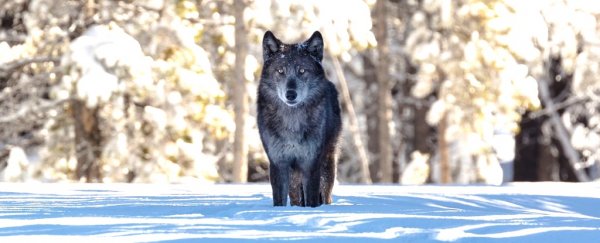Yellowstone isn't just a supervolcano. It isn't just a national park. It's also a science lab, even if it doesn't really look like one.
And not just any science lab, either, but the site of the "most celebrated ecological experiment in history", according to a new study.
In a broad overview of over 40 years of research at Yellowstone National Park, University of Alberta ecologist Mark Boyce looks at how a reintroduction of wolves to Yellowstone that began in 1995 ended up having vast ecological ripple effects beyond what anyone could have envisaged at the time.
"Yellowstone has benefited from the reintroduction of wolves in ways that we did not anticipate, especially the complexity of biological interactions in the park," explains Boyce.
The wolves were not always so popular.
In 1872, when Yellowstone was first designated as a national park, there was no legal protection for any of the existing wildlife within it, and over the decades to come, mass culling programs killed thousands of wolves, resulting in what was widely regarded as a successful extirpation (localised extinction) within Yellowstone by 1926.
This forced removal, however, had unintended consequences for the park.
In the absence of the deadly apex predator, the local elk population flourished, with booming numbers leading to mass overgrazing that resulted in widespread deterioration in a number of plant species, in turn causing land erosion and various knock-on effects on other animals.
Within a scant timeframe of only years, the elk had replaced the wolf as the face of Yellowstone's ecosystem issues, but it wasn't until decades later that calls to reintroduce the wolf were finally heard and acted upon.
"Eventually, in 1995, 14 wolves from Alberta were released in Yellowstone, supplemented by another 17 Canadian wolves in 1996," Boyce writes in his paper.
In the space of five years, these 31 individuals multiplied into numerous, distributed wolfpacks.
They thinned the elk and thus helped to bring about an ecological phenomenon known as a trophic cascade – a reduction of predation (in this case, of elk eating plants) that triggers changes for other diminished or affected species throughout an interconnected food chain.
In the case of Yellowstone, Boyce says the woody plants willow and cottonwood in particular sprang back thanks to reduced elk, as did bison, possibly thanks to less competition from elk.
Overall, this demonstrates a trophic cascade that he describes as being "among the most significant advances in conservation biology of this century".
A much-loved YouTube video that's been watched almost 40 million times tells the same story, although it's also been criticised for oversimplifying the complex ecosystem interactions. Still, it's definitely an inspirational viewing:
But did it really happen like the video makes out?
Ever since the wolf reintroduction narrative became a kind of 'ecosystem restoration' trope in popular science, numerous studies and commentators have pointed out it's not quite that simple.
These voices argue elk weren't as affected as we might have thought, and say the restoration is nowhere near complete.
"It's a really romantic story," Utah State University ecologist Dan McNulty told AccuWeather in April.
"It's a story about a world that doesn't really exist."
From this point of view, we're doing ourselves a scientific disservice if we get too wrapped up in the 'wolf saviour' stereotype, because there's a lot more going on in Yellowstone ecologically.
"We now know that elk are tougher, and Yellowstone more complex, than we gave them credit for," wildlife ecologist Arthur Middleton from UC Berkeley wrote in The New York Times in 2014.
"By retelling the same old story about Yellowstone wolves, we distract attention from bigger problems, mislead ourselves about the true challenges of managing ecosystems, and add to the mythology surrounding wolves at the expense of scientific understanding."
That's a good point to bear in mind, but from the seasoned, sober perspective of Boyce's multi-decade research, there's no denying wolves did help to shape a trophic cascade in Yellowstone National Park – a transformation made possible by essentially removing another dangerous animal from the equation: us.
"We would have never seen these responses if the park hadn't followed an ecological-process management paradigm," Boyce says, "allowing natural ecological processes to take place with minimal human intervention."
The findings are reported in Journal of Mammalogy.
